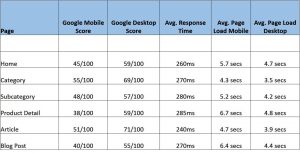
Brand Experiences Don’t Live In A World Of Their Own. They Have To Be Evaluated Against Customer Expectations
Unknown to you, every potential and existing customer of yours, when he hits a contact point with your brand, comes with an expectation set in his mind. This dictates how he perceives and devours your brand. He measures the experience he gets from your brand with the expectations he had in mind. Your brand may come off favorably or unfavorably in this evaluation.
So what then is brand experience? The dictionary defines “experience” as “an event or occurrence which leaves an impression on someone.” So brand experience is that elusive “impression” your brand leaves on someone who comes across it, as against the expectations he had of the encounter.
At Solohacks Academy, we’ve found that there are four things that matter here:
- Where and when did the potential customer come across your brand touchpoint (point of contact)?
- What shaped his expectations of the encounter in his mind at that moment?
- What experiences did he get from the contact with your brand at that touchpoint?
- What resulted from that contact? Was the potential customer impacted enough by his experience to explore your brand further?
We hope this article will help you learn what the expectations of customers are – so that you can choreograph brand experiences that match up to or exceed expectations.
1. Understanding The Value Of Brand Experience And Its Challenges For Businesses
As we said earlier, businesses have to know more about their customers’ expectations before they begin to build their brand experiences. Let’s first look at some why brands often find brand experience design very challenging but also very valuable …
a. The Difference Between Brand Experience And Experiential Marketing
There is a lot of market confusion about two concepts that sound similar but are entirely different. One is “brand experience building”. The other is “experiential marketing”.
Brand experience building is about giving the customer the right experiences to match or exceed his expectations along his buying journey, at all the touchpoints he has with your brand. On the other hand, “experiential marketing” is about creating high buzz events or activity around your brand to give customers a multi-dimensional, multi-sensory overload of experiences.
Experiential marketing is often a one-time thing, when you create a heightened experience of your brand by staging events. For example, if your knowledge of fine wines allowed you to create a live “blindfolded wine-tasting event”, you’d create a massive buzz that may spike interest in your brand. It would be about creating an “experiential event” but it would not come under what we commonly know as “brand experience”.
Brand experience is about making your brand look extraordinary in the everyday transactions it does with its everyday consumers.
As long as you have the customer – or potential customer – engaged in the expectations vs. experience game with you, you’ve obliterated the competition from his mind for a while. Unless you fail so badly on the experiences, the customer won’t be looking elsewhere.
b. About Touchpoints And Their Tracing Along Customer Buying Journeys
What are touchpoints? “Touchpoint Guru” Hank Brigman defines a touchpoint as “… an influential action initiated by communication, human contact or sensory interaction. Each touchpoint is a message that literally “touches” a customer in some way. Collectively, touchpoints create the customer’s experience.”
See the first diagram below. This diagram shows you the typical 8-step customer buying journey, and what kinds of information a brand needs to give at each of the 8 stages of the buying journey to satisfy customer needs in a broad way.
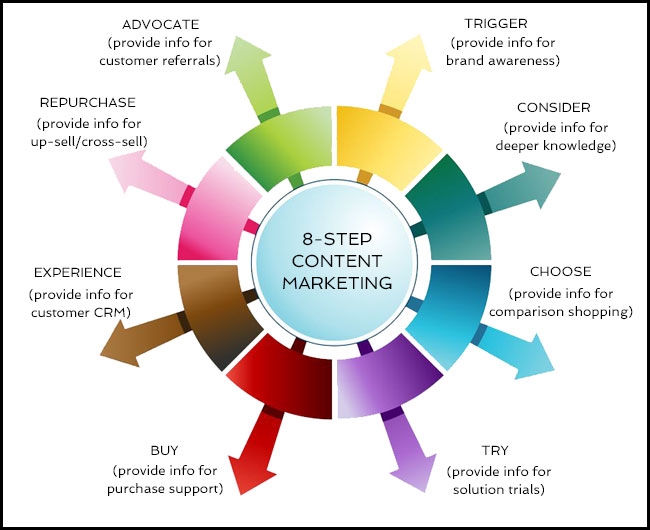
The customer is TRIGGERED by some need or problem to solve, he CONSIDERS his options and CHOOSES one of them to TRY out. If he likes what he sees, he BUYS and then EXPERIENCES the sales and after-sales service. If he is happy he REPURCHASES a lot, and he then also ADVOCATES the brand to his friends and colleagues.
The diagram also shows the kind of informational content a brand needs to offer customers to help them at each stage of this journey.
What we don’t see in the diagram is the spaces between any two stages of this journey. Between Stage 1 (TRIGGER) and Stage 2 (CONSIDER) there could hundreds of small touchpoints, like these …
- When customers come back to your site to explore more blog posts than the ones they first read
- When readers may subscribe to your newsletter
- When there are emails going to and from your brand to customers
- When you may be using retargeting to remind customers of your brand
- When customers may write to you to ask queries
See this diagram below now. It shows you that along the buyer journeys there can be many touchpoints that you don’t see until you try to brainstorm, or actually take stock of them by customer research.
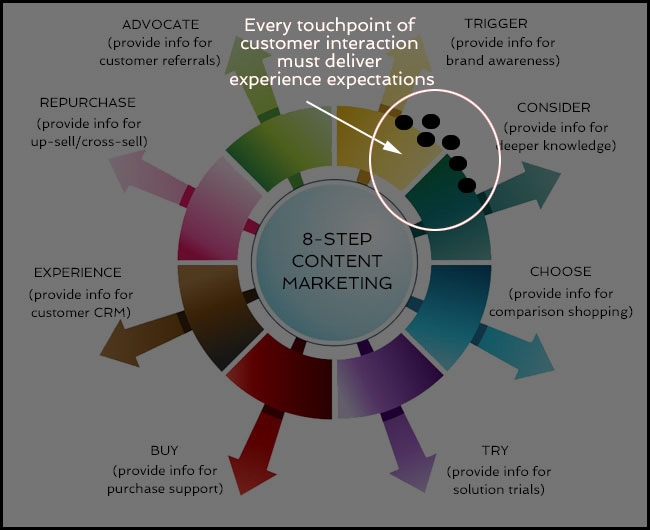
Although we have shown a simplistic version of how touchpoints lie along the buying journey, in real life it could be more complex than this.
c. Plotting Brand-Consumer Touchpoints Can Be Highly Challenging
While there’s no doubt that touchpoint mapping is imperative for brand marketing in these complex times, the challenges of getting it perfectly right are also a bit daunting.
- The first hurdle to cross, for brand marketers, will be the question of how to keep the customer journey mapping at pace with the evolution of technology, social platforms, and customer behavior. Maps can get dated very fast and it is an onerous and continuous task to see that the customer journey maps stay up-to-date with what is happening on the ground.
- The second challenge is to be able to put numbers to everything on a customer journey map. Without the metrics, the ROI of brand marketing will be hard to calculate. The latest area of difficulty for brand marketers is “visual social content” that defies quantification. Content like micro-videos, apps or even the new content designed for wearable devices – all of this complicates the gathering of meaningful and actionable metrics. But wherever possible along the customer journey mapping process, cost calculations need to be factored in, and thus maps can be not just action aids but costing aids as well.
- The third issue, which I mentioned right at the start of this post, can be analysis-paralysis. Trying to get too much into a map can fuddle the brainiest in the brand team. Remember, it’s very easy to complicate maps and very hard to keep maps simple. While a good map is an invaluable tool for helping brands make their way through the labyrinths of the new marketplaces along with their customers, having no map is distinctly safer than having an incorrect, dated or misleading map. If you get the map right, the brand marketing, despite today’s complexity, becomes a breeze. If you get the map wrong, you will yourself send your customers on a wild goose chase.
- The fourth problem to guard against is creating a map from the brand’s point of view rather than the customer’s point of view. I have seen a lot of customer journey mapping done more as an exercise of what the brand would like to see happen, rather than as a piece of strategy derived from really listening to and understanding the customer.
- The fifth challenge is a tricky one. To the customer his path always looks like a journey. But to the brand, a campaign always looks like a series of a disconnected and independent set of messages. The secret is for brands to be able to discover customer journeys so that seemingly disparate pieces of brand advertising can be strung together with alignment, cohesion, meaning and purpose.
2. How To Design Your Brand Experiences For Maximum Customer Delight
Since the objective of creating brand experiences is to match or exceed customer expectations, let’s see what those expectations are – and then how we can smartly offer the experiences people will find beyond the expected.
a. Customers’ Minimum Expectations Of Any Brand Experience – 10 Key Points
Don’t begin to believe you are delivering a great brand experience if you meet the ten criteria that are the very minimum customer expectations. You have to match all these and then go over and beyond to become a hallmark of brand experience.
- Speed: Most customers don’t want to take time on any on-site decisions. Once they decide, they want to click-and-get. So ensure there are no impediments delaying them and increasing irritation.
- Truth: People expect nothing short of authenticity from you and have no time for frilly talk or roundabout misleading communication. Be straight and true to your word.
- Consideration: In general buyers like to left alone to make their decisions but when they need your help, that’s not when to leave them high and dry to make sense of your site. Be there to hand when needed.
- Familiarity: People expect you to know and recognize them from past visits to your site. They no longer think this is impossible. They have heard of automation and they think you’d better have the means to know your customers.
- Accessibility: The online world never sleeps. Some parts of the world and customers there are awake when you are asleep. Nevertheless, when they need you, you have to be there. That’s automation again if you can’t have a 24×7 back-office.
- Ease of use: Don’t think your site will be easy to navigate just because you have signposted everything on your navigation framework. People don’t read those at all. They need idiot-proof ease-of-use.
- Immediacy: Most online customers don’t react well to replies like “It will get to your inbox in 24 hours.” A download, a purchase, a reply to a query – all these had better be right in the moment. It needn’t be a great delivery with fanfare, but it has to be immediate.
- Listening: Buyers don’t want sellers asking too many questions. They prefer to be the asking ones and the sellers better have responses. When you are asked to respond that’s not when you launch into “Let me get to know you better” surveys.
- Good site design: Never mind that you spent big dollars on the best site designer in the countryside who built you a complex website. People want simple sites they can understand the contours of in a trice. So hold that spending and get a simple but elegant site.
- Responsiveness: Setbacks do happen. They will happen. The least a customer wants is quick, responsiveness to the core problem. Hold back that detailed problem-solving attitude. Speed counts. Put that Band-Aid on the main issue. Get to the finer details later, if you must.
Remember, this is the minimum brand experience expectation of every customer at every touchpoint. You must try to exceed expectations. But beware of exceeding expectations at any one touchpoint, while leaving the rest to chance.
b. Finessing The Brand Experience At Touchpoints
Audit your every touchpoint for its brand experience. First, see if the touchpoints meet all the customer expectations listed above. Then see what qualitative factors you can add to make the touchpoint more than expected. Here are the key questions to ask yourself to see if your touchpoints can be qualitatively improved to be experientially outstanding.
- Does this touchpoint give the right brand authority impression?Is the impression created by the touchpoint aligned to your brand strategy overall? Does it help reinforce your brand values? Does it help reinforce your brand differentiation over your competitors? What is there in this touchpoint to make the customer feel he is dealing with a knowledgeable expert whom he can rely on for high-quality information and interactions?
An example would be to offer an “expert tip” at each touchpoint to give the customer a hint of which would be a better choice if he has to make a choice … or a tip on how to get the most out of the touchpoint to make his buyer journey easier.
For instance, if a customer is at a touchpoint that demands a certain level of knowledge to make a decision, wouldn’t it be mighty useful to add an “expert tip” that says “Hint: My recommendation to you would be XYZ if you want to improve your traffic – and my recommendation would be ABC if you want to increase conversions.” Everyone would find that useful and their higher expectation of you as an authority would be served.
- Does this touchpoint create learning or insight moments in customers?If you make each touchpoint delivering a little bit of extra knowledge or insight to customers, you can make the interaction become more memorable and valuable. Customers don’t regularly expect their minds to be widened in mundane activities – which gives you a chance to deliver something more than expected.
One example of this would be to give customers the results of a poll taken at that touchpoint to show him what other customers have chosen when they were here. For instance, if he were at a touchpoint where he has to choose whether to take a free trial of your product, it may help to add a “poll result” that says “Of the 50 people polled here, 35 found it useful to take the trial. 27 said they found the XYZ feature unexpected but good. See if you agree.”
- Does this touchpoint have enough explanatory text or videos to make it easy to navigate?Little do sellers realize that a timely video, or “quick tour” just BEFORE a touchpoint can avoid so many tangles a customer may have to go through on your site’s touchpoints that are a bit complex.
One example of this in action would be a touchpoint, say, where the customer has to make a payment. Perhaps he needs to know the drill on your site because your payment processor may have a slightly more complex process than the customer is used to. Many sellers make it a step-by-step process and say” “Step 1: Sign up here with a login and password of your choice.” After the customer takes that step, the seller would say “Step 2: Select your ideal payment gateway.” This way the seller would give just the right instructions for each step as the customer goes forward.
But I have found that explaining the whole rigmarole fully before the customer gets into the action sequence seems to help much more than giving instructions at each step. For instance, you can say “Here’s what to expect in our 4-step process you’ll go though next …” It’s a small thing that makes a big difference. Someone, who knows what it will take, strides forward confidently. Whereas someone getting instructions one step at a time goes forward tentatively. Remember this one axiom for all touchpoints. People fear the unknown. So forewarn and forearm them – and it adds to consumer confidence no end.
- Does this touchpoint have an incentive for the customer to go to the next step of the journey?One of the main jobs a touchpoint has to do is to make the customer want to take the next step. You can make a touchpoint to achieve this objective by incentivizing the customer for taking both this action and the next.
For example, one way to incentivize the customer in taking the next step would be asking if he’s like to bypass this step for quicker progress. Let’s say, a customer is toying with a trial of an app you have created. You may like to ask: “Are you sure you want to take the free trial – or would you like to proceed to buy? You can save time, plus if you’re not thrilled you can still fall back on our 30-day refund guarantee.”
Another way to incentivize customers to take the next step would be to give a discount for opting for the next step if the current one is taken. For example, if a customer is about to take your short course, you could say: “Great decision if you sign up for this short course. You’ll also earn a 10% discount on the longer course when you decide to take that.”
That suggests he may want to take the next larger course (nudge, nudge) – and if he doesn’t he loses the discount which to him is money left unclaimed.
- Does this touchpoint have a detailed map you’ve sketched out of all possibilities?I’m always amazed that some businesses and brands never plan for all the possibilities that can happen at their touchpoints. They only worry about getting right what they think is going to happen. Nine times out of ten, your assumptions may not be matched by customer behavior at the touchpoint.
A brand that really bothers to design and map every single touchpoint it has is the airline Emirates. Just look at the detail with which they have sketched out all possibilities at every point of contact between their brand and their customers.
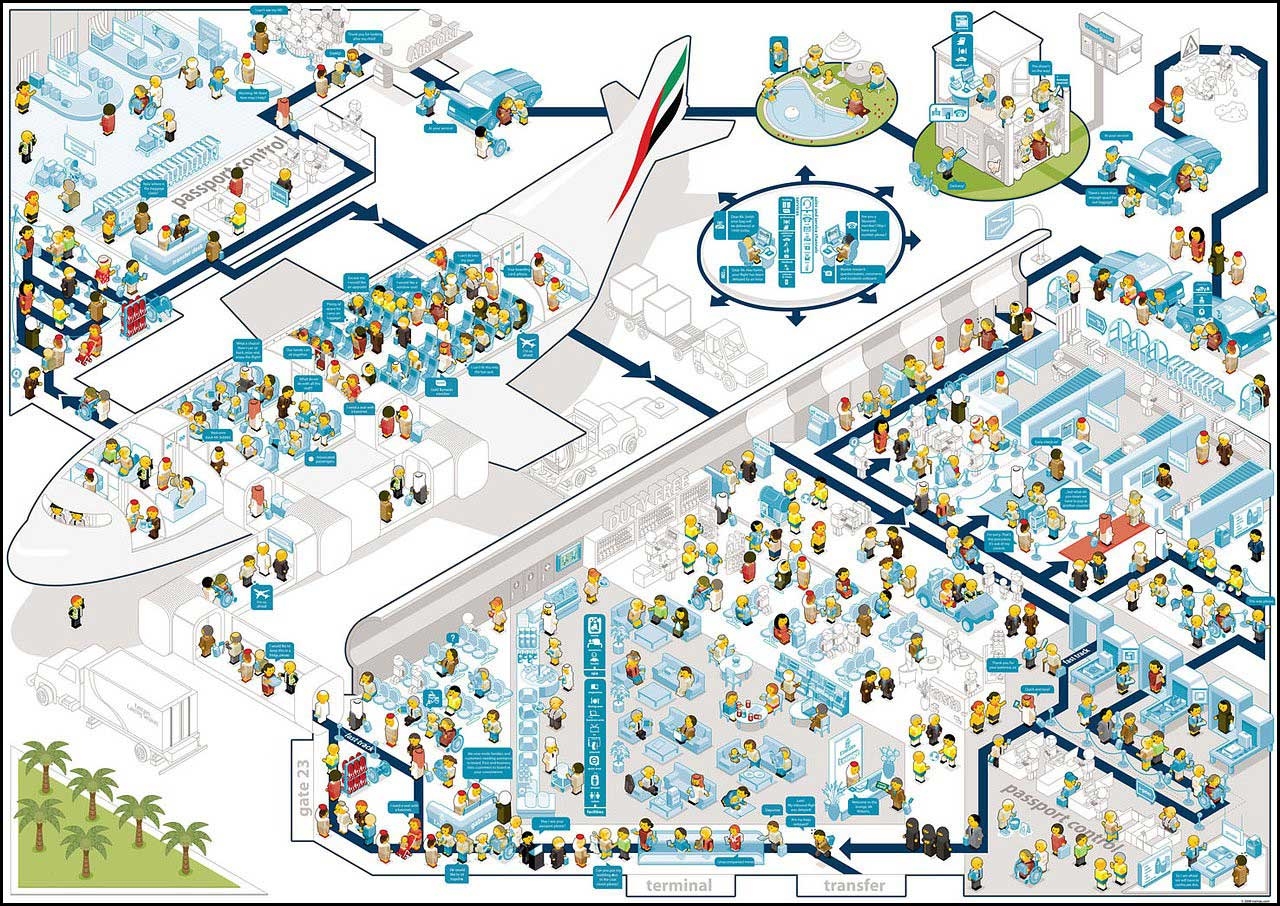
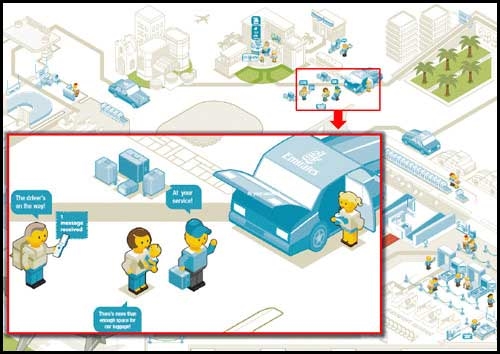
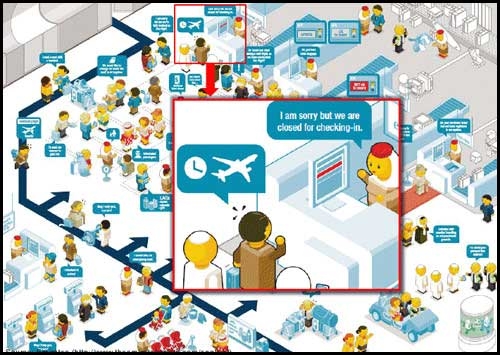
Images courtesy: Jack Dorsley
c. Over-Servicing And Over-Surveying: The Two Brand Experience Killers
You can do too little for improving your brand experience. But there are also businesses that do too much in the name of improving brand experience. I’m talking of the pestering that too much servicing and too much surveying can do to kill all the satisfaction a customer gets from interacting with your brand.
- The perils of over-servicing: A real-life storyI have to tell you about a brand experience I had at a hotel where I was staying, where they took the idea of “hospitality” so seriously that I had to scream for them to hear me say “Stop!” It wasn’t an online brand, but I’ve seen the same mistake committed online too.
After a hard day completing four long meetings back-to-back, I returned to my hotel room, placed the “Do Not Disturb” sign on my door and took a tablet to get rid of a pounding headache. Tap, tap, tap went the door. So I got up to see a hovering and well-meaning, beaming room steward say he had come to turn down my bed, and was there anything else I wanted?
Barely had I sent him out when another tap on the door brought a maid with some chocolates – marked “Good Night Goodies”. Hardly had she left after looking around and fluffing up my pillows, when there was another “helpful man” at the door saying would I like to place my order for morning tea right now so I get bed tea in the morning to my utter bliss. I said “No” a trifle rudely because my head was pounding hard by now.
You guessed it. There was another senior steward at the door with a form that said they’d be grateful for my feedback on how they were doing in their service. By now I was boiling mad -and I couldn’t do much but pretend not to hear any more taps on the door. I never went back to that “extremely well-intentioned hotel” again.
When people write that brand experience must be pleasant and memorable, they have to add a caveat that too much pleasantness and memorability also grates.
- The survey after survey after survey that kills youHere’s another story I can never tire of telling, because it’s gone from being a small irritant to a huge peeve. Every time I give my car to the repair-and-service company for routine servicing I get five feedback-request emails after the service.
- One comes from the mechanic assigned to service my car saying, “How did I do?” If I don’t answer it, he calls to say his job will be on the line.
- That’s followed by his supervisor who asks, “How did my mechanic do?” If I don’t answer this, he calls to say his boss has set him a target for customer feedback, so can I please help.
- Then the boss of the servicing company asks, “How did we do?” If I don’t answer, I get more emails that repeat the question and say my “service ticket” is still open.
- Then the auto manufacturer company asks, “How did our servicing company do?” If I don’t answer, the servicing company calls and says the manufacturer is badgering them to get my feedback.
- Then the boss of the auto manufacturer asks, “What can we do to make your experience better?” You bet I am bursting at the seams to tell him!
This story has one more part to it which is an unforgivable brand experience-killer. My car was earlier in my father’s name, and after he passed away I took ownership of it in my name – after informing everybody from the car manufacturer to the servicing dealer that the transfer of ownership had been done (father’s death certificate attached herewith, etc). But for six years after my father’s demise, the feedback questionnaires arrived in my father’s name!
3. Three Other Advantages That Can Result From Your Brand Experience Strategy
Besides just offering customers some great brand experiences, there are three other reasons why you must aim to improve your approach to brand experience design. Here they are:
a. Building Great Brand Experiences Keeps Your Brand Consistently Customer-Centric
When you get conscious of creating great brand experiences, you take you mind off your business and your goals to look at things from a customer point of view. You’ll find you cannot design brand experiences without understanding customer psychology, being truly customer-centric, and looking at how to drive the customer forward on his journey.
Customer-centric businesses are laser-focused on providing customer-pleasing experiences. To make brand experiences innovative, such businesses often disrupt their industries and are often rewarded with growth and increased revenue. Brands that have superior customer experience are believed to bring in 5.7 times more revenue than their competitors.
Ultimately, being customer-centric should go beyond brand experience design and become a cultural way of life for your business, impacting everything you do.
b. Building Great Brand Experiences Gives You A Big Competitive Edge In Fierce Markets
Data from Gartner reveals that as many as 89% of businesses will compete mainly on brand experience going forward. Walker backs this claim, predicting that brand experience will overtake price and product as the key brand differentiator for B2B by end 2020. Businesses will be deploying more and more resources into brand experience in order to build an early advantage.
For marketers wanting simple math, it costs 6 times more to get new customers than to keep existing ones. Retaining the interest of traffic that falls into your net, before they are tempted to jump into the competitor’s net, is the name of the game. Brand experiences become the tool of choice for brand marketers who want to hold the interest and loyalty of their interested audiences.
At every touchpoint, the customer – or the potential customer – evaluates you. The sum total of the evaluations of all the touchpoints, that a consumer makes about you, adds up to your impact on the customer.
With every satisfactory touchpoint, in fact, customer expectations may grow, challenging you to keep up. When people see you are good, they expect more from you. If you can keep up, it all adds to your edge over competition.
The fiercer the market, the better has to be your brand experience, because these touchpoints are where the rubber hits the road. Your claims and promises get tested against actual delivery. Treat every touchpoint as a chance to pip the competition to the post. Where you can sail is where others of lesser customer-centricity may fail.
c. Building Great Brand Experiences Keeps You Evolving With Fast-Changing Customer Trends
In the article by SalesForce, the marketing software, there is some very revealing research on how fast consumer expectations are changing about what constitutes a great brand experience. They quote The State Of The Connected Consumer Report to say that:
Customers expect great experiences but reality falls short. In this era of exponentially disruptive technological change, often referred to as the Fourth Industrial Revolution, products and services that are cutting edge one day are outdated the next. In this context, the experience a company offers is increasingly its differentiator. But the scope of customer experience is changing, too. To win hearts and wallets, companies must not only deliver amazing marketing, sales, ecommerce, and service interactions, but also prove that they have the customers’ best interests in mind.
Customers expect a lot from companies, but don’t have faith in them to deliver. About half of customers say most companies fall short of their expectations for great experiences. The reality is that today’s customers expect companies to understand and care about them as individuals, and treat them accordingly.”
One main problem seems to be that technology is raising customer expectations at a breakneck pace. But since businesses are not able to pivot their brand experiences at the same pace, they seem to be consistently falling short of expectations.
Another main problem, as seen from the survey responses chart of the Report shown below, is that customers feel that something is missing in brand experiences – but they don’t articulate it with greater precision. Notice how they say they want more “consumer-like” experiences.

Image courtesy: Salesforce
The solution to fast-changing customer expectations is not to try and match every changing expectation (which will be well nigh impossible) but to identify the key touchpoints that are most critical to customer decisions – or those that are most vulnerable to customer leakage. In those identified areas, give extra priority to checking changing customer expectations frequently, and tweak your brand experiences to keep up.
In Summary …
- Brand experiences don’t live in a world of their own. They have to be evaluated against customer expectations.
- At every touchpoint along the buyer’s journey, the customer evaluates your brand experience against his expectations.
- Learn what expectations of customers are – so you can choreograph brand experiences that match up to or exceed expectations.
- Identifying and choreographing brand experiences at each touchpoint can be challenging, but also highly rewarding.
- Small, but customer-centric, changes to your brand experiences at touchpoints may change your results quite dramatically.
- Make sure your over-zealousness about brand experience building doesn’t get to customer irritation levels. That’s overkill.
Business & Finance Articles on Business 2 Community
(24)


